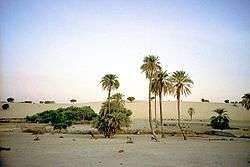Mao, Chad
| Mao | |
|---|---|
|
Oasis village Mao Chad | |
 Mao Location in Chad (Kanem highlighted) | |
| Coordinates: 14°07′10″N 015°18′48″E / 14.11944°N 15.31333°ECoordinates: 14°07′10″N 015°18′48″E / 14.11944°N 15.31333°E | |
| Country |
|
| Region | Kanem |
| Department | Kanem |
| Sub-Prefecture | Mao |
| Population (2008) | |
| • Total | 19,004 |
| Time zone | +1 |
Mao is a city in Chad, the capital of the Kanem Region and of the department also named Kanem. It is the 16th most populous city in Chad.
As in other Chadian regions, Mao is ruled by both a traditional Sultan and by central government officials. Moves toward decentralisation have been stymied by the complex and sometimes tense relationships between traditional rulers in Chad and national authorities.
On the border of the Sahara, Mao's geography is marked by sand dunes and sparse vegetation.
A large majority of Mao's residents are Muslim. However, there are two Christian churches (one Catholic and one Protestant) in Mao.
The town has a small airport, Mao Airport (IATA: AMO, ICAO: FTTU), with a paved runway.
History
Mao was established in 1898 by Sultan Ali, brother of the sultan Djourab who was murdered by the fezzans and other accomplices. Since 1900, Mao was the real administrative centre of the north. It is inhabited mostly by Kagas (Kogonas), the magoumis the dazzas the azzas the fezzans the Toubou the kredas the toundjours and others. The town of Mao is now administered by a governor State authority and a sultan who is the iconic and historical authority even if the administrative perspective kanemiens because they are much more attached to the sultanate in the administration (sign of the story).
Source: Tilo Mission (1900). Natchtigal under the mission Thillo spent in Kanem in 1898, at which time the register of Sultans in Kanem to 40 successive sultans. starting with Dounama Dilabami to His Majesty the Sultan Ali Bié.
Demographics
| Year | Population |
|---|---|
| 1993 | 13,277 |
| 2008 | 19,004 |
References
- Joël Thomas, 'Enquête exploitation dans la région de Mao (Kanem),' 1990, 1991, 134 p.
- Gustav Nachtigal, « Excursion au sud du Kanem », in Sahara et Soudan, Hachette & Cie, Paris, 1881, p. 440 and following
